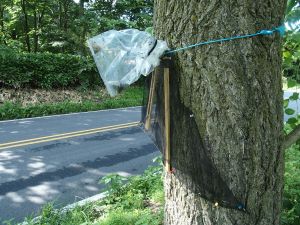OLD Circle Traps
The circle trap is a newly adopted control mechanism originally engineered by Rachel Bergey from Harleysville, PA. Her invention piqued the interest of homeowners and scientists alike for its highly effective mitigation efforts. The idea was to build a trap that manipulated the spotted lanternfly’s instinct to climb upwards towards the light. In short: in her prototype the invasive species crawled up through a mesh lining until they reached a receptacle that traps them.

Research performed by PSU extension has shown that these circle traps are extremely effective in SLF mitigation and dramatically reduce by-catch (accidental capture of non-target species such as birds, small mammals, and other insects). Additionally, the dead-end collection container is a more sustainable option than using sticky bands as the container can be reused.
Circle traps do not have to be installed on the Tree of Heaven. These traps can be used on any tree where there is a significant SLF presence. The tree of heaven is the most preferred tree for SLF but there are large populations found on maple, walnut, willow, poplar, sycamore, cherry, apple, peach, and other angiosperms (I.E flowering trees).
For installation tips, here is Penn State extension’s demonstration on how to attach a circle trap to your prioritized tree:
If you would like a formal step-by-step outline, we have included our circle trap instructions below. To purchase the circle trap being used in the instructions please visit Great Lakes IPM.
